
Cambridge - Its Railways and Station[Source:
Darren Kitson]
Part 2: The Pre-Grouping Period To recap from Part 1, we have seen the arrival of the lines from Huntingdon and St Ives, Peterborough via Ely and the Newmarket line via its original route converge on Cambridge. We have also seen the coming and going of the two original island platforms as well as touching upon the changes of 1863.
In time, the use of platforms 2 and 3 became transposed; Bedford and Stour Valley line trains tended to use platform 3 while London trains via both routes tended to use platform 2. platform 3 was also prone to being used for parcels traffic and this remained the case well into BR days. The north bay was restricted by the pre-existing (1847) engine shed and this is the reason why platform 6 butted right up against the east wall of the shed. The original North and South signal boxes also appeared around this time; these being at different locations to the post-1926 signal boxes - specifically, in line with the ends of the main platform and thereby limiting scope for further platform and track alterations. It was partly for this reason the signal boxes were later relocated east of the platform and through roads, with the main reason being better sighting of the goods roads and carriage sidings. At this point we will go briefly out of sync and mention that the alterations of 1908 included a further platform lengthening. This extended the platform to 1,515ft; the maximum deemed practical with the North and South signal boxes at their then locations.
The Engine Bay
At the same time as the south bay was built, an engine bay was also provided and this is seen above in 1904. Photographic evidence suggests, as above, that it was often home to a wagon but its intended purpose was for locomotives waiting to take over southbound trains. It is also thought the company's Merryweather steam fire engine was also stabled in the engine bay on a flat wagon at one point in time. The engine bay is said to have still existed in 1921 but ceased to appear on plans after 1927, this notwithstanding the 1908 platform alterations.
Above is another view of the engine bay, this time in 1908. The locomotive is interesting; it is Class T19R 4-4-0 No. 707. These machines began life as James Holden Class T19 2-4-0s; 29 were rebuilt from 1902 with Belpaire fireboxes and new boilers but they were somewhat ungainly and came to be known as 'Humpty Dumpties'. From 1905 a further 60 T19s were rebuilt into 4-4-0 form, No. 707 being one of these. She was later fitted with a superheater and was withdrawn by the LNER, as Class D13 No. 7707, in 1937. The last of the T19Rs bowed out in 1944, while the un rebuilt 2-4-0s had all gone by 1920. Note the Westinghouse pump just in front of the cab. The GER was a Westinghouse railway, meaning it used air, as opposed to vacuum, braking. Some locomotives, however, were also fitted with a vacuum ejector for working other companies rolling stock. Of the original T19 2-4-0s, the last was withdrawn in 1913, while the 'Humpty Dumpties' had all gone by 1920. All building and rebuilding was undertaken at Stratford works, which had replaced the original ECR works at Romford.
The above image dates from LNER days, c1929, but it is convenient to show it here as a comparison. By this time, the engine bay had gone and platform 1/2 had been lengthened. The start of the platform ramp can just be seen on the left. Compare the platform with that seen in the previous two images, using the canopies and buildings as reference points. Given that the platform in the c1929 image is at its post 1908 length it is difficult to see how the engine bay could survive beyond 1908 without the extended platform 1 being dangerously narrow at its southernmost 100 or so feet but, apparently, that was the case.
Above is a general view of the station's south end in 1906. As can be seen from this and previous images, the station was looking decidedly shabby around this time even when allowing for the degrading of photographs that are over a century old. In the days of steam locomotives, domestic coal fires and the chimneys of industrial premises, buildings became dirty and shabby very quickly. Indeed, the buildings of the Romsey and Petersfield areas of Cambridge were blackened for over a century until the air began to become cleaner from the 1960s. A GNR train can be seen in the bay platform but it appears to be stabled in the centre road rather than in one of the platform roads. In June 1883 some alterations to what was described as the 'GNR platform' (ie platform 3) had taken place because the tracks were too close. No further details are known but we can assume the alterations involved a narrowing of the platform and realignment of the track. This may explain the peculiar kink which existed for many years at the buffer stop end of platform 3. The cast iron urinal on the platform was provided in 1884 at a cost of £75. Once a common sight at both large and small stations, they were handy in the days before corridor trains with toilets became common; the waiting passenger, male of course, could relieve himself without the need to walk to the station building and risk missing his train. Many such urinals were roofless or had a rudimentary clerestory or a sort of half roof covering just the cisterns and they were almost always cold, damp and breezy irrespective, it always seemed, of the time of year. A few of these urinals have been saved and re-erected on heritage railway stations and working museums while some still remain, usually now with listed status, at non railway locations but as far as the national rail network is concerned they are relics of a bygone age. On the platform, in front of the urinal, can be see two ghosts. They appear to be male but who they were when in this world is not known. Perhaps they died on the railway or perhaps they were men who occupied the land before the railway was built. We just do not know, so readers are left to decide for themselves. The stories of the arrival at Cambridge of the two companies involved with the south bay, the London & North Western (LNWR) and the Great Northern (GNR), are rather complicated so we will give brief insights covering just the main events. The London & North Western Railway The Bedford & Cambridge scheme swallowed up most of the already existing Sandy & Potton, better known for its locomotive Shannon which ended up on the Wantage Tramway. The Bedford & Cambridge Railway was planned from the outset to be operated by the LNWR so to keep matters simple we will refer hereinafter only to the LNWR which, in the event, had effectively taken control of the B&C in June 1864 and absorbed it entirely in July 1865. *Surprisingly there is some confusion over the actual date the GER came into being. It seems the date from the organisational aspect was 1 July 1862 while the relevant Act came into effect on 7 August 1862.
Above the site of what was very nearly the second railway station for Cambridge can be seen. Obviously taken during LMS days, the year is thought to be 1934. At this time the goods station was managed by Pordage & Co., a local and well known fruit and vegetable merchant. Hills Road is on the left and the road off to the right is Brooklands Avenue. Hills Road bridge is near the telegraph pole seen in the left background. The buildings survived until relatively recently and today a modern NHS building occupies the site but the large radius of the street corner is still evident. A record has survived from British Railways days informing us that ladies toilets were not provided in the offices at this goods station until 1952. Although the railways have always been, at least until recent times, a male dominated industry, the lack of facilities for ladies was more of an accepted way of life than anything else. This is also highlighted by the platform urinals as seen in the earlier image, even though there were almost as many women passengers as there were men.
The above view, probably taken at the same time, shows part of the platform side of the LNWR goods depot looking towards Brooklands Avenue. The lettering on the shed on the left stated L&NW AND MIDLAND RAILWAYS GOODS DEPOT. During the late 1970s, Fyffes occupied the building on the right and they kindly gave permission for the Cambridge Group of the M&GN Joint Railway Preservation Society to work on two recently withdrawn King's Cross suburban coaches which had been purchased and delivered to the siding by BR. However, it was found the two coaches had corrosion problems for which repair was beyond the scope of the available facilities. As a result, both coaches were later moved to Sheringham. This was the last known use of the siding seen above. The non-corridor loco-hauled suburban coaches became notorious for corrosion around and below the window frames, as just about every heritage railway which has restored them discovered. The last of these coaches on BR survived until mid 1970s on the King's Cross - Baldock/Royston/Cambridge outer suburban services.
Above is Cambridge London & North Western Junction, looking south from Hills Road bridge c1910. This junction was usually referred to more simply as Cambridge Junction. The London lines run to the left, diverging to their three London termini at Shepreth Branch Junction, and the Bedford line branches off to the right. At this time, trains from Cambridge to London ran to Liverpool Street, King's Cross and St Pancras. In the distance the LNWR Cambridge Goods Yard signal box can be seen and the tracks on the extreme right ran to the LNWR engine shed and to the goods depot seen in the previous two images. Until c1980 the sidings on the right served Cambridge Coal Concentration Depot and one track of the former Bedford line remained in situ as a headshunt to just short of Long Road. The distant signal on the right seems to be rather oddly sited and it is not clear to which track it applied. It appears to be controlled from Cambridge Goods Yard signal box, in which case it probably controlled the exit from the LNWR goods yard or engine shed and the seemingly odd positioning might have been for sighting reasons. The track on the left led from the up goods yard and at this time it ended at the buffer stop just visible in the distance. It later formed part of the up goods loop which joined the up main at Long Road. The down goods loop is seen joining the down main in the centre of the image. Coprolite excavations were extensive in the area but died out during the early 20th century. Coprolite, as the link above explains, is fossilised faeces and existed in large quantities, insofar as the Cambridge area is concerned, in a belt stretching roughly from north-east Cambridgeshire down into Hertfordshire. Many people mistakenly think Cambridge is in the Fens; it isn't, it actually sits on slightly higher ground to the south. Millions of years ago, had Cambridge existed then, it would have been near, or on, the coast and what today is Fenland was then the bottom of the sea. This is why we have names such as Isle of Ely, because what is now Ely sits upon what was once an island after the sea had receded and left behind the wetlands we now call The Fens. This higher ground, safe from the sea, was populated by animals, including dinosaurs. Over a long period of time, their faeces changed composition into a mineral form. These mineral forms came to be known as 'coprolites' and when processed made excellent fertiliser. This was the purpose of the H&B works. Coprolite was extracted by what we would today call the open-cast mining process. The Cambridge area and in particular Trumpington had numerous such workings, most using narrow gauge tramways to either take the coprolite direct to the processing works or for transshipment onto the main line railways or to transport the end product to the main line for distribution. A well known local example of the latter was Francis siding on the Mildenhall branch. Fisons, the now defunct but well known chemical and fertiliser company which also operated weed killing trains, one of which was stabled for many years at Foxton, began life in 1843 as a result of the coprolite industry. Coprolite was not just used to make fertiliser either; perhaps bizarrely it was also used to make jewellery and other decorative items. When the coprolite industry died out, the excavations were either infilled or simply left to flood - sometimes with the narrow gauge tracks still in situ. Today little trace remains, unless you know precisely what to look for. One fairly well known coprolite tramway was located beside the Bedford line close to where the line passed under Hauxton Road (A10) and the last visible remains of this were destroyed as a military training exercise sometime around 1970. Hallack & Bond, incidentally, were instrumental in organising the Cambridge celebrations for the Coronation of HM Queen Victoria in 1838 and had a shop on Petty Cury, a street in the centre of Cambridge, in the former White Swan inn, until 1926 when the business appears to have folded. The picture below shows open cast mining for coprolite at Orwell, south-west of Cambridge c1880.
Lieutenant-Colonel H. A. Yorke R.E. for the Board of Trade reported that it was the practice of the LNWR to bring trains to a halt in terminal platforms by means of the guard applying his handbrake and the fireman applying the locomotive handbrake. Even Lieut. Col. Yorke had difficulty interpreting this, which was LNWR Rule 293, and he assumed it to mean reliance must not be placed entirely upon the driver applying the vacuum brake although "drivers are permitted to use the continuous brake in the circumstances described". In noting this, Lieut. Col. Yorke was making comparisons with a similar incident at Manchester London Road during March of the same year. This all appears very strange to us today in our health and safety obsessed world but Rule 293 was probably a harbinger from the time when trains relied upon nothing but handbrakes and the vacuum brake was still viewed with a degree of mistrust. The Armagh disaster of 1889 tragically highlighted only too clearly the danger of trains not fitted with the continuous automatic vacuum brake. At Cambridge, the LNWR train had been checked by a signal as it approached Cambridge Junction but the signal was pulled off and the train had a clear run into the station but collided with the buffers at an estimated speed of 10mph. Cuts and bruises were reported but no deaths or serious injuries. Driver Downs had blamed greasy rails (a common excuse, apparently) due to fish vans having previously been in the bay platform. However, Lieut. Col. Yorke concluded the collision occurred because the guard had failed to apply the handbrake and this was backed up by witnesses on the platform who noted the wheels of the brake vehicle were freely revolving as the train entered the bay. Blame was therefore placed on the guard, notwithstanding criticism of Rule 293 and doubts that driver Downs had applied the vacuum brake once he realised his train was not going to stop despite an apparently unconfirmed statement by fireman Bolton that the vacuum brake was normally applied when approaching the Cambridge bay platform. Driver Downs had also reported that he overshot the water column at Bedford and had to reverse his train in order to take on water. He also reported that his train had departed Lord's Bridge station six minutes late, but there is no evidence this had any bearing on the accident. The Great Northern Railway In its attempts to reach Cambridge, the GNR leased the Royston & Hitchin and by August 1851 had pushed on as far as Shepreth, a mere eight miles from Cambridge station and just 5½ miles from what would become Shepreth Branch Junction. Through passengers then had to make do with a horse-drawn bus onwards to Cambridge. This was not as dire as it may seem for until not so long previously the entire London - Cambridge journey by stagecoach had occupied at full day. The never-to-be ECR service to Hitchin was intended to be temporary until the GNR had located a site for its own station in Cambridge and several sites were considered; the favoured site being near the botanical gardens. This plus the similar situation with the LNWR partly accounts for the large number of proposed station sites outlined in Part 1. When the line finally opened throughout in 1866, the GNR had been granted running powers over the Shepreth - Cambridge section and the line therefore never saw a timetabled passenger train of the GER with all services being operated by the GNR. This in turn meant the stations at Harston and Foxton were never served by a train of their owning company until the formation of the LNER in 1923. Harston station closed in 1963 and discounting station relocations, renamings and the temporary stations at Maiden Lane (the original London terminus) and Trumpington it has so far been the only station between King's Cross and Cambridge to do so. The financial side of things was far from smooth, however. The arrangement was for the GER to construct the facilities for the GNR and recover the money in the form of rent. In July 1866 the cost had been estimated at £4,300 but a year later, in July 1867, the GNR had to loan the GER £4,000 to complete the unfinished work. Therefore the financial arrangements became reversed, with the GER being in debt to the GNR. The GNR station had its own staff, stationmaster, booking and other offices, living accommodation and cab rank. This situation prevailed until 1910, after which the GNR shared the GER booking office. The GNR station eventually became a parcels office. July 1867 and the loan from the GNR were significant for the GER had been placed into receivership and some of the GER's assets were, in effect, pawned. A number of locomotives, for example, had little plates fixed bearing names of creditors making, on paper anyway, these locomotives the property of the creditors. By the end of 1869, however, the problems had been resolved and a rosier future beckoned. One of the locomotives plates has survived and is now in the Wisbech & Fenland Museum. This plate names Alexander Tracy, a March based contractor, as one of the locomotive's theoretical owners. Tracy was the contractor engaged by the GER to build the GNR engine shed. Another situation interesting enough to mention occurred after the GNR had arrived at Cambridge and during, it appears, 1884. The GNR already had lines in Lincolnshire including that from Spalding reaching down into Cambridgeshire at March but had wanted powers to run to, among other places, Newmarket, Great Yarmouth and March over GER lines from the south. The result was numerous arguments, proposals and counter-proposals from both sides, one of which was a GNR proposal to build a line from Shepreth direct to March. The locations of all proposed stations sites for Cambridge are known (see Part 1) but none tie in with the GNR's proposed Shepreth - March line so the scheme was most likely, as said, nothing more than a bluff. Had it been built it would have provided a useful freight route avoiding Cambridge, especially during wartime, but it is unlikely it would have survived the so-called Beeching Cuts. We will never know.
Getting back to reality, above can be seen the former GNR station building in July 1983, in use as a parcels office. Platform 3 is behind the left side of the building and the GER station building is behind and to the left of the photographer. Beneath the awning was a gated exit from the platform, just behind the Reliant car. The passenger entrance to the building was in the west elevation and is now hidden by the rather hideous single storey addition overlooking the large puddle; this area once being the cab rank for the GNR station. There was a large sign proclaiming 'Great Northern Railway' on the west wall below the three central first floor windows and above the passenger entrance. The building ceased being a passenger station in 1910, when facilities were moved to the GER booking hall. The GER, GNR and LNWR all had their own goods and locomotive facilities, while the Midland shared facilities apart from the goods shed near Mill Road which period maps claim existed during the late 19th century. These facilities will be detailed later. The GNR also had its own hotel in Cambridge, at the junction of Station Road and Hills Road. It is extant as of February 2015 but has long since ceased to have any connection with the railway other than its name,
Above is a GNR Ivatt 4-4-0 in the south bay at Cambridge, date unknown but after 1911. The train is an odd mix of six-wheelers and at least one of Gresley's 1911 articulated pairs. The latter were later rebuilt to form the first batch of four-car sets better known as Quadarts. The Body in the Bag Mystery Such an event today would be considered horrific but in the 19th century incidents like this were not uncommon for a number of reasons. However, the most likely explanation for this particular case is that the child was illegitimate, had died (the infant mortality rate was high those days) and the body simply abandoned in a bag spuriously addressed to simply get it well away from Cambridge. We must remember that terrible stigma was attached to unmarried mothers until relatively recently and in Victorian times - and later - quite draconian measures could be taken. If an illegitimate birth could not be concealed, the child would be taken away, usually to an orphanage, while the mother would be disowned by her family, treated as though she had never existed and in all probability placed in an asylum. For those reasons, illegitimate children were often simply abandoned - dead or alive. We do not know the truth behind the body in the bag at Cambridge station but the aforementioned scenario is likely to have applied. The Trains of the Dead Persons so-executed were, until 1832, the only legal source of corpses for medical dissection but the supply was woefully inadequate and that is where the so-called 'body-snatchers' found their niche. Illegally obtained corpses were sold for dissection to otherwise perfectly respectable medical professionals in, among other places, London and Cambridge (Burke and Hare operated in Edinburgh). In an attempt to wipe out this illegal trade The Anatomy Act 1832 was passed. This made it legal to use for dissection corpses of those who had died in prison ['died' meant by any means, not just by judicial hanging] or in pauper workhouses. This did not, however, bring an end to unscrupulous activities. The Master of the Great Yarmouth workhouse, for example, was known to record a dead person as having been buried when in fact the coffin was full of sand or some other substance to give it weight and he had sold the corpse and pocketed the money. Before the coming of the railways, corpses had to be transported by horse and cart. If the journey was lengthy, and especially during summer, one dreads to think what state the corpses were in when they reached their destinations. When the railways arrived the corpses were transported by train and companies such as the Eastern Counties Railway would almost certainly have been involved but the Great Eastern Railway is known to have been involved. An unknown number of corpses were taken by train from the Great Yarmouth workhouse to the Anatomical Theatre of Downing College, Cambridge. The corpses were transported in what were known as 'death-boxes', presumably some sort of rudimentary coffin. It is said that death-boxes were conveyed initially in the brake vans of ordinary passenger trains but due to complaints, or for fear of complaints - it is not clear which, dedicated vehicles were later attached to trains. Whether these were full-brake, goods van or some sort of corpse van as used by other railway companies is not known. Nor is it known for certain what the precise arrangements at Cambridge station were but in all probability the 'death-boxes' were unloaded in the same way as any other goods arriving by passenger train. The practice seems to have lasted into the early 20th century when it was discontinued. British Rail finally abolished the transporting of occupied coffins by train as late as the 1980s (1988 is it believed) other than for certain occasions on a one-off basis; the last known occasion being in August 2001 for the funeral of the trades unionist Jimmy Knapp. Station facilities and staff - 1866 onwards Apart from the Newmarket deviation of 1896, the only line yet to arrive at Cambridge in 1866 was that from Fordham, in 1884. When we look at the railway stations of today with their somewhat clinical atmosphere and with fears of being sent to Alcatraz for boarding a train with the wrong type of ticket no matter how innocently it was purchased, it is easy to forget just how different stations and rail travel was a century and a half ago. For example, first class really did mean first class while third class, well, meant you may have found yourself sitting on a wooden bench seat and, at stations, porters ignoring you as they rushed to assist first class passengers who were likely to tip generously. In those days Cambridge station had separate waiting rooms for the different casses as well as ladies waiting rooms, two cavernous refreshment rooms (one each end of the building), a bookstall, two booking offices (three if we included the GNR's own facilities) and numerous offices necessary for the day-to-day goings-on of the four railway companies then serving Cambridge. There were coal fires, gas lighting, oak panelling - all the trappings, normal for the time, which gave a pacifying feeling of permanence which has long since been confined to history. The station bookstall is thought to have existed since the station opened but the first written mention of it, which has been discovered, dates from November 1859 when, it was recorded, it was moved further along the platform from its [presumably original] site adjacent to the ladies waiting room. The refreshment rooms, one of which was later closed, appear to have been run on a contract basis during GER days if not also LNER days. There are a number of surviving references mentioning refreshment room managers who, when leaving the position for whatever reason, were responsible for installing their own replacements whilst at the same time reporting to GER management in order to keep them informed. There are also a number of surviving reports concerning fire damage to the refreshment rooms and the north end refreshment room seems to have been particularly prone. This was the least busy of the two and is likely to have been the one which the GER closed. There is one aspect of Cambridge station in particular, partly touched upon above, which few people today are aware of. Most people assume a railway station had a stationmaster but Cambridge had one for each company which served it. From opening in 1845 until under British Railways in 1987, Cambridge station had no less than 47 stationmasters. The position of stationmaster is now referred to as 'Station Manager' but the role has changed; today the job is largely administrative and involves things like patronising passengers by referring to them as 'customers', but at one time the stationmaster was a senior figure very much in the public eye who had worked his way up from the lowest grades and was competent in many aspects of railway operation. He ruled with the proverbial rod of iron and woe betide any employee who as much as reported for duty one minute late. Details of all stationmasters who served at Cambridge are known but as details are lengthy we will name only the first stationmasters of each railway company. ECR - R. J. Watt; GER - A. Fisher; GNR - W. Flack; LNWR - W. Edbury; Midland Railway - B. Pepperdine. It is convenient here to also mention the post 1923 Grouping and BR days; LNER - A. Peacocke MBE; British Railways - S. N. Wright. The final stationmaster under British Rail was C. H. Wells who became Area Manager when roles were revised in 1987. Under the LMSR the first stationmaster was F. W. Miller who served until 1929 when the LMSR abolished the position of stationmaster at Cambridge. Mr Miller is thereafter shown as being simply the LMSR 'Passenger Agent'. Presumably it was a choice of that, relocation or redundancy; the 1920s was not a good decade, with a series of strikes culminating in the General Strike of 1926 and then the so called 'Wall Street Crash' of 1929. The financial effects of these events may well have been responsible for the disbanding of Mr Miller's former position. One other Cambridge stationmaster is worth a mention; William Bright, who served with the GER as stationmaster from 1884 to 1894, was largely responsible for encouraging many social activities for Cambridge railwaymen as well as later being the driving force behind the Cambridge division of the St John Ambulance. Staff residential accommodation was somewhat scattered. There were railway cottages at Mill Road, while Devonshire Road and the parts of Romsey Town which sprang up in the 19th century provided much staff housing as did the Russell Street and Norwich Street area off Hills Road. The GNR stationmasters are thought to have lived in the GNR station building but details of residences for the other stationmasters are not known. Apart from stationmasters, companies serving Cambridge also had other local staff for goods, parcels, deliveries, portering and so forth. All these functions required office accommodation and public facilities within the station area and this accounts for the large number of extra offices and other buildings added to the station as the19th century progressed. All this was over and above the additional staff employed at the various engine sheds and goods depots dotted around the station area. The LNWR differed from the other companies that operated to Cambridge in that its tracks extended all the way into Cambridge, apart from the last few yards from Hills Road into the station over GER metals. The LNWR was thus the only company, other than, of course, the GER, to have its own signal box in Cambridge. This was the so-named Cambridge Goods Yard signal box, located south of Hills Road and controlling the goods loop (on the Bedford line) and junction to the LNWR goods yard. It operated in conjunction with Hills Road Junction and, later, Cambridge South signal boxes as well as Trumpington ground frame which was located just north of Long Road. Manned by LNWR and LMS men, it later came under the jurisdiction of BR Eastern Region, as did the line as far as Willington. During the Second World War, in 1943, there were alterations to Trumpington sidings and to Cambridge Goods Yard signal box. The siding layout at Trumpington was ultimately very similar to that at Belle Vue, Gamlingay.
Click here to continue Part 2: The Pre-Grouping Period
|
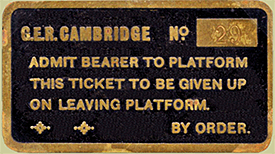 The two bays were not built at the same time, however. The south bay appeared first, originally as a single platform (what today is platform 2), followed by a second platform (what today is platform 3) by 1866 for the arrival of the GNR. The north bay was intended also for Newmarket trains; the deviation line via Coldham Lane Junction being planned for at least 25 years before it was finally built. Delays in constructing the deviation appear to have been the reason for an additional connection from the original route of the Newmarket line into what is today platform 5. This connection was equally as awkward as that serving the main platform but it did have the advantage of getting Newmarket trains out of the way of other trains using the main platform. All these alterations tend to be grouped historically under the '1863 alterations' banner.
The two bays were not built at the same time, however. The south bay appeared first, originally as a single platform (what today is platform 2), followed by a second platform (what today is platform 3) by 1866 for the arrival of the GNR. The north bay was intended also for Newmarket trains; the deviation line via Coldham Lane Junction being planned for at least 25 years before it was finally built. Delays in constructing the deviation appear to have been the reason for an additional connection from the original route of the Newmarket line into what is today platform 5. This connection was equally as awkward as that serving the main platform but it did have the advantage of getting Newmarket trains out of the way of other trains using the main platform. All these alterations tend to be grouped historically under the '1863 alterations' banner.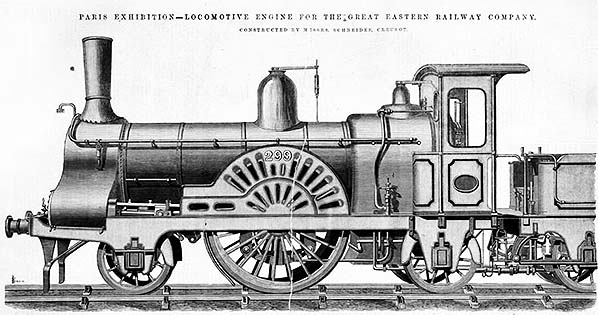
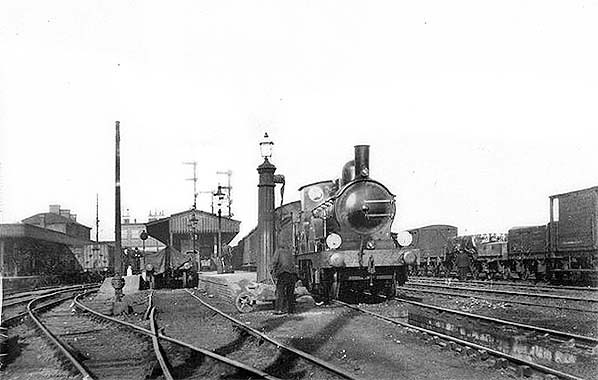


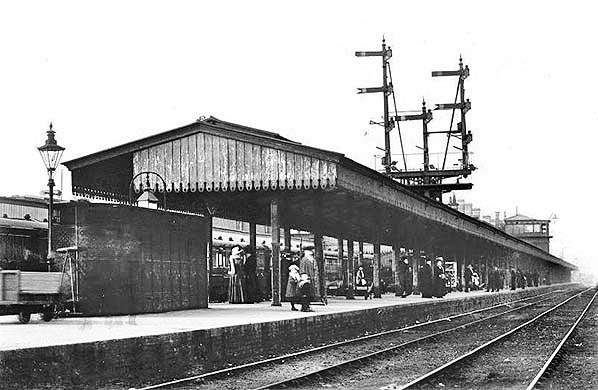
 While construction of the Bedford and Cambridge line was ongoing, Cambridge station was still in its pre-1863 form. The LNWR was therefore looking for a location for its own station in Cambridge. Several sites were considered, including Silver Street and Northampton Street, but a site at the junction of Hills Road and Brooklands Avenue (then known as Linton Road and Brooklands Road respectively) was decided upon. Although near the GER, as it became in 1862*, the LNWR station would have been inconvenient for passenger transfer. Following the friction outlined earlier, things became more amicable and with the alterations at Cambridge station imminent it made sense for the LNWR to use the GER station and share the costs and this was indeed what happened. It is not known what, if any, construction had been started for the LNWR station but the site became the LNWR, later LMS, goods depot and this was shared with the Midland Railway. The Midland also had a goods yard just south of Mill Road on the down side; Mill Road Wharf.
While construction of the Bedford and Cambridge line was ongoing, Cambridge station was still in its pre-1863 form. The LNWR was therefore looking for a location for its own station in Cambridge. Several sites were considered, including Silver Street and Northampton Street, but a site at the junction of Hills Road and Brooklands Avenue (then known as Linton Road and Brooklands Road respectively) was decided upon. Although near the GER, as it became in 1862*, the LNWR station would have been inconvenient for passenger transfer. Following the friction outlined earlier, things became more amicable and with the alterations at Cambridge station imminent it made sense for the LNWR to use the GER station and share the costs and this was indeed what happened. It is not known what, if any, construction had been started for the LNWR station but the site became the LNWR, later LMS, goods depot and this was shared with the Midland Railway. The Midland also had a goods yard just south of Mill Road on the down side; Mill Road Wharf.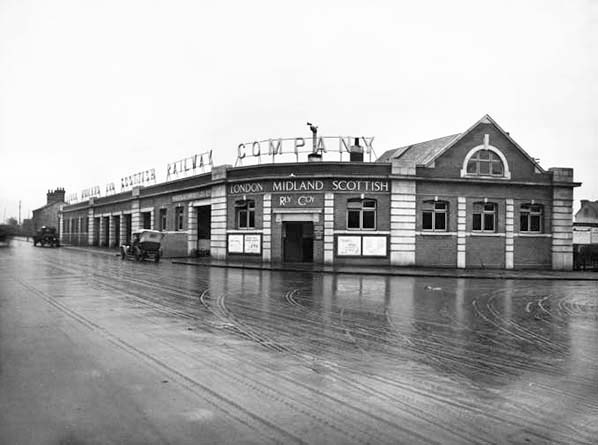

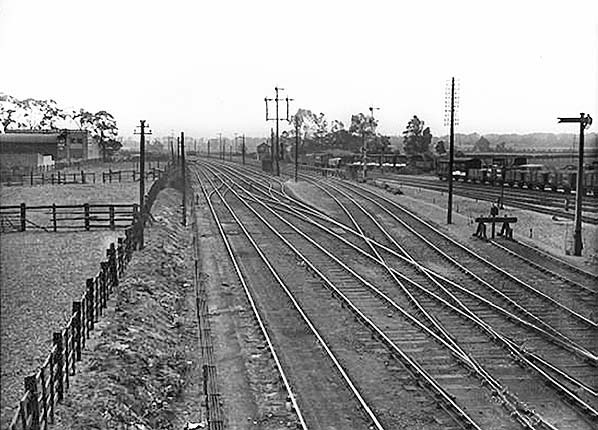
 Cambridge Goods Yard signal box is sometimes mistakenly referred to as Trumpington signal box; to modern eyes it was nowhere near Trumpington and the latter box was located further south on the GER line at Long Road. Cambridge Goods Yard signal box was at the end of a long Block Section from Lord's Bridge and worked in conjunction with Cambridge South and Trumpington ground frame. None of the railway locations named Trumpington were actually located in Trumpington subsequent to 1912 and the answer lies in the time the railways were built. Trumpington is now part of the City of Cambridge but at one time it was a village just outside the Cambridge boundary and the land to the north of Long Road was also part of Trumpington. In 1912, this land was transferred to Cambridge and in 1934 Trumpington village itself became part of Cambridge. Thus when the railways were built, the naming of signal boxes and other locations as Trumpington was geographically correct but the names were retained following boundary changes. Retention of names which had become outdated was common practice on railways everywhere and is also, in some instances, the reason some railway location names are apparently misspelled.
Cambridge Goods Yard signal box is sometimes mistakenly referred to as Trumpington signal box; to modern eyes it was nowhere near Trumpington and the latter box was located further south on the GER line at Long Road. Cambridge Goods Yard signal box was at the end of a long Block Section from Lord's Bridge and worked in conjunction with Cambridge South and Trumpington ground frame. None of the railway locations named Trumpington were actually located in Trumpington subsequent to 1912 and the answer lies in the time the railways were built. Trumpington is now part of the City of Cambridge but at one time it was a village just outside the Cambridge boundary and the land to the north of Long Road was also part of Trumpington. In 1912, this land was transferred to Cambridge and in 1934 Trumpington village itself became part of Cambridge. Thus when the railways were built, the naming of signal boxes and other locations as Trumpington was geographically correct but the names were retained following boundary changes. Retention of names which had become outdated was common practice on railways everywhere and is also, in some instances, the reason some railway location names are apparently misspelled.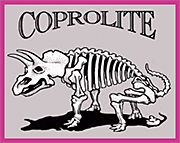 Near the signal box seen above, a little-known branch once swung away towards the right of the image. This connected the coprolite works of Messrs Hallack & Bond to the LNWR line. Hallack & Bond (H&B) were grocers who imported agricultural produce among other related activities. The H&B works and its rail spur are known to have been in existence in 1870 as a track plan from that year has survived, but it is not known when it closed. Click
Near the signal box seen above, a little-known branch once swung away towards the right of the image. This connected the coprolite works of Messrs Hallack & Bond to the LNWR line. Hallack & Bond (H&B) were grocers who imported agricultural produce among other related activities. The H&B works and its rail spur are known to have been in existence in 1870 as a track plan from that year has survived, but it is not known when it closed. Click 
 Meanwhile, in 1852, the ECR had decided to build its own branch to Shepreth but at this point things become a little unclear. The ECR scheme made the GNR decide to lease the Hitchin - Shepreth line to the former to enable some sort of through train service to be provided (by the ECR) but nothing happened until 1866, by which time the ECR had become a constituent of the GER. What is unclear is when precisely construction of the section south-west to Shepreth had actually begun, but we do know the stations at Harston and Foxton were built and owned by the GER and not by the ECR so most, if not all, construction was post 1862. The Cambridge - Hitchin line therefore ended up as two separate branches making an end-on connection and it is for this reason the junction at Shelford is known to this day as Shepreth Branch Junction.
Meanwhile, in 1852, the ECR had decided to build its own branch to Shepreth but at this point things become a little unclear. The ECR scheme made the GNR decide to lease the Hitchin - Shepreth line to the former to enable some sort of through train service to be provided (by the ECR) but nothing happened until 1866, by which time the ECR had become a constituent of the GER. What is unclear is when precisely construction of the section south-west to Shepreth had actually begun, but we do know the stations at Harston and Foxton were built and owned by the GER and not by the ECR so most, if not all, construction was post 1862. The Cambridge - Hitchin line therefore ended up as two separate branches making an end-on connection and it is for this reason the junction at Shelford is known to this day as Shepreth Branch Junction.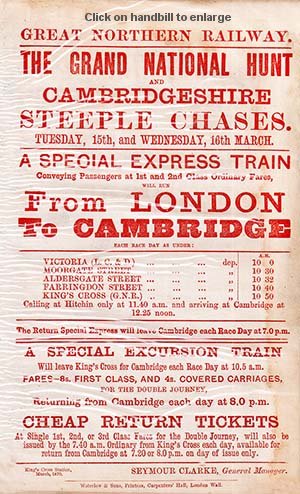
 The proposed Shepreth - March line was probably little more than a bluff but it is interesting to speculate on what would have happened had it been built. It would have been some 30 miles long and the likely route, taking into account the topography of the region, would have been from Shepreth via Comberton, Madingley, Willingham and Chatteris or a shorter route from Shepreth via Elsworth to St Ives from where it would have joined, powers permitting, the existing route to March. Madingley, on the western fringe of Cambridge, is a fairly hilly area so had this line been built it is likely it would have passed to the east of Madingley and very close to the site of what is now Cambridge crematorium. At the time, Cambridge had not spread as far northwest as Girton (a village situated immediately outside the present-day city boundary) but even so the line would have passed within three miles of the centre of Cambridge so it is hard to believe no station would have been provided, as inconveniently sited as it would have been.
The proposed Shepreth - March line was probably little more than a bluff but it is interesting to speculate on what would have happened had it been built. It would have been some 30 miles long and the likely route, taking into account the topography of the region, would have been from Shepreth via Comberton, Madingley, Willingham and Chatteris or a shorter route from Shepreth via Elsworth to St Ives from where it would have joined, powers permitting, the existing route to March. Madingley, on the western fringe of Cambridge, is a fairly hilly area so had this line been built it is likely it would have passed to the east of Madingley and very close to the site of what is now Cambridge crematorium. At the time, Cambridge had not spread as far northwest as Girton (a village situated immediately outside the present-day city boundary) but even so the line would have passed within three miles of the centre of Cambridge so it is hard to believe no station would have been provided, as inconveniently sited as it would have been.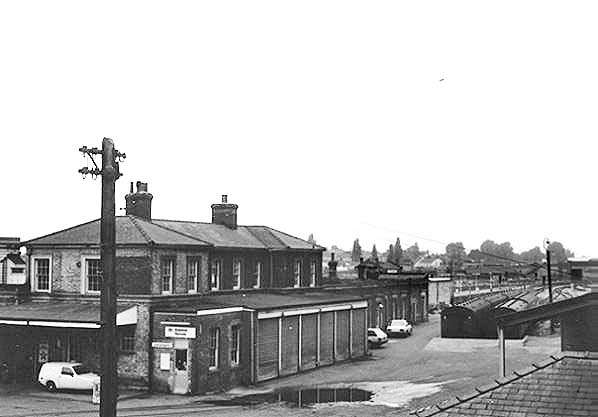
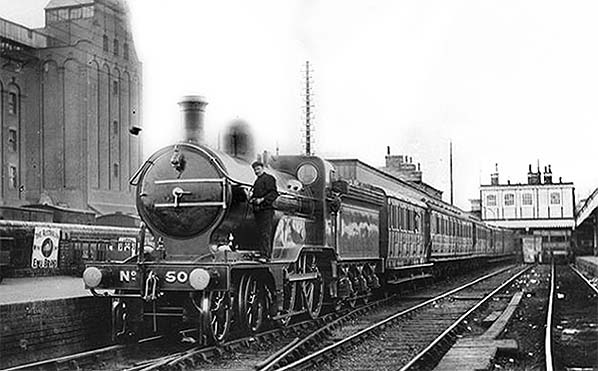
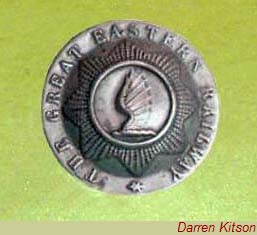 Finally, a photograph of a young Eastern Counties Railway porter has survived. He wears a waistcoat with brightly shining buttons and a jacket with a large ECR monogram on his right arm. On each lapel is boldly shown his employee number, 506. We do not know who this young boy was and he will have died over a century ago. If only he could talk to us from his photograph.
Finally, a photograph of a young Eastern Counties Railway porter has survived. He wears a waistcoat with brightly shining buttons and a jacket with a large ECR monogram on his right arm. On each lapel is boldly shown his employee number, 506. We do not know who this young boy was and he will have died over a century ago. If only he could talk to us from his photograph.

 Home Page
Home Page